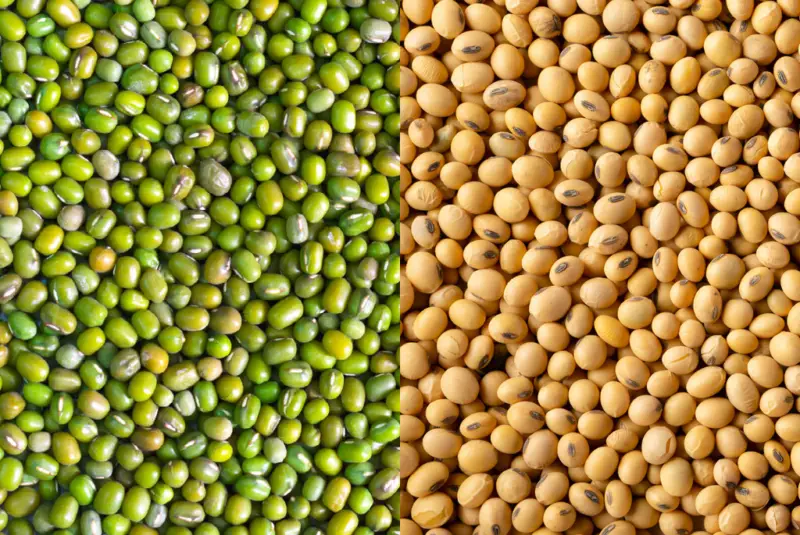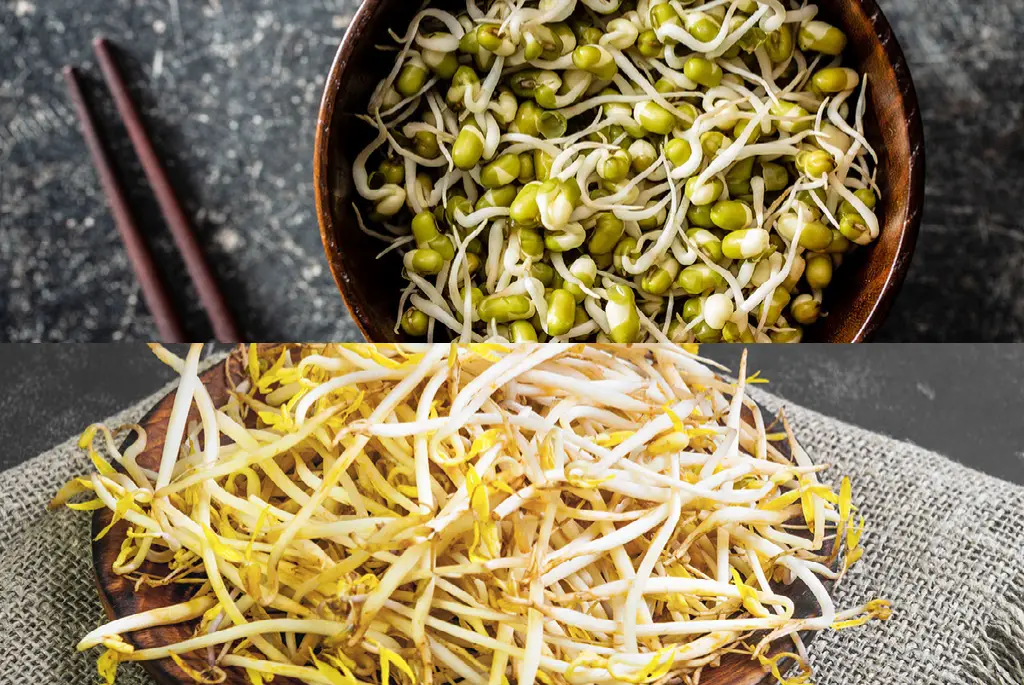This post may contain affiliate links. Please read my disclosure for details at the bottom of this page. As an Amazon Associate, I earn from qualifying purchases on this post about kongnamul vs sukju-namul, otherwise known as soybean sprouts vs mung bean sprouts. We hope you enjoy learning the difference between these two popular Korean ingredients!
When I first started to learn how to cook my husband’s cultural cuisine, I had no idea where to start. Every flavor seemed new and unusual. Eventually, after many failed attempts at cooking ‘authentic’ Korean dishes, I realized that learning about the individual ingredients would help me establish a basis for how Korean flavors are developed. After all, they are very different from those I grew up using. This education led me, over the past few months, to write about and publish articles about Korean ingredients such as gochugaru, perilla leaves, napa cabbage, green plums, and more. The purpose of these articles is to help teach readers about the common ingredients used in Korean cooking–that way, it can help them when cooking new recipes just like it helped me!
Over the last two weeks, I individually wrote about two common Korean ingredients: soybean sprouts and mung bean sprouts. Since then, I have gotten a few emails from readers asking a few common questions: 1) how do you distinguish between the two sprouts, 2) how do people in South Korea use these sprouts differently, 3) do these sprouts taste different?
So, here, we will compare the two sprouts and ask the question: ‘soybean sprouts vs mung bean sprouts, what is the difference?’
Soybean Sprouts vs Mung Bean Sprouts: What Is the Difference?
Below, we list the answers to many of your questions about soybean sprouts vs mung bean sprouts. If we do not answer your question, feel free to leave a comment in the section below or email us at [email protected].
1) Type of Bean:
While this may seem obvious, I am still going to list this as a major difference.
Mung bean sprouts grow from mung beans.
Soybean sprouts grow from soybeans.
On one hand, mung beans, known as ‘nokdu’ (녹두) in Korean, are a plant species in the legume family known as Vigna radiata. Dried mung beans are distinguished by their dark green color and small size. From these beans, you can grow mung bean sprouts, known as as ‘sukju-namul’ (숙주나물). You do this by immersing them in water for about 12 to 24 hours. Then, they will sprout in 2 to 5 days. Eventually, the green outer shell of the mung beans falls away leaving yellow heads of the sprouts. To learn how to sprout mung beans, I recommend reading about the process on Maangchi’s blog or watching her Youtube video explanation.
On the other hand, soybeans, known as ‘mejukong’ (메주콩) in Korean, are a plant species in the legume family known as Glycine max. Dried soybeans are distinguished by their creamy yellow-green color as well as their larger and rounder shape. From these beans, you can grow soybean sprouts, known as ‘kongnamul’ (콩나물). You do so by immersing the beans in water for approximately 12 to 24 hours. Then, you cover the beans so that no light penetrates. Eventually, the beans will sprout in 4 to 6 days, once again losing their outer hard shell from the beans in the process. Like the mung beans, I recommend learning to sprout soybeans through Maangchi.
2) Appearance:
At first glance, it may be difficult to distinguish between soybean sprouts and mung bean sprouts, as they look very similar. While both have yellow-ish heads with white stems when ripped enough to consume, there are a few notable differences to help you distinguish between the two types of sprouts.
Mung bean sprouts, also just called bean sprouts, have thicker stems, flat heads, and petite yellow leaves attached to the head and steam shoots. You will notice the heads are approximately the same thickness as the actual stem.
Soybean sprouts have a much larger head in comparison to the stems. These stems are skinnier and longer than the mung bean counterpart. Soybean sprouts do eventually have the small leaves attached to the head and stem but these show up much later than the mung bean alternative. Often, people eat the soybean sprouts before the little leaves appear.
3) Flavor:
Mung beans have a subtle grassy and nutty flavor when eaten raw or cooked. They taste light and refreshing as a result of their high water content. Texturally, mung bean sprouts are crisp and crunchy.
Like mung bean sprouts, people describe soybean sprouts as having a grassy, earthy, and nutty flavor while also having as having a stronger ‘bean’ flavor than other sprouts. Texturally, soybean sprouts taste light, refreshing, and crisp.
4) Uses:
The use of these sprouts varies vastly depending on the culinary customs attached to a country or group of people. In some countries, such as certain regions of China, mung beans are the prominent sprout used in dishes. People in South Korea use soybeans on a more regular basis.
In South Korea, people commonly eat mung bean sprouts fresh in a type of salad known as ‘sukju-namul muchim.’ People either eat this salad as a banchan or over rice dishes such as bibimbap. Finally, they use mung beans to make the bean flour base of savory pancakes known as ‘Bindae-tteok.’
Like I just stated above, people more commonly eat soybeans and soybean sprouts in Korea. Often, they eat the sprouts in salads known as ‘kongnamul.’ Further, people cook with them in stir fry dishes as well as soups and stews. The beans are used to make important cultural ingredients such as doenjang (Korean soybean paste), tofu, soy sauce, and more.

5) Availability:
In the United States, and other western countries, you can easily find mung bean sprouts in a well-stocked grocery store. Often, grocery stores label mung bean sprouts as just ‘bean sprouts.’
Unlike mung bean sprouts, soybean sprouts are difficult to find in your typical western grocery store. Instead, to find soybean sprouts, shop at your local Asian grocery store or market. For those who do not live near an Asian market, you may need to grow soybeans.
We Hope You Enjoyed Comparing Soybean Sprouts vs Mung Bean Sprouts!
In the end, I hope you enjoyed learning about the differences between soybean sprouts and mung bean sprouts, especially in Korean cooking. If so, let me know in the comment section below! Further, let me know of recipes you enjoy that use either of these two sprouts!
If you would like to read more about cooking, you can find further recipes on this blog. I listed some of my favorite Carving A Journey recipes below! For reference, many recipes are influenced by my family’s blended Korean and Southern heritage.
Korean Ingredient Articles:
- Green Plums in Korean Cooking (Maesil)
- What are Perilla Leaves (Kkaennip)?
- Dangmyeon (Sweet Potato Glass Noodles)
- Gochugaru (Korean Pepper Powder)
- Korean Soy Sauce: What Should I Buy?
- Gluten-Free Gochujang Brands
- Gluten-free Doenjang Brands
Further Carving A Journey Korean Recipes:
- Mung Bean Sprout Salad (Sukju-Namul Muchim)
- Korean Cabbage Pancakes (Baechu Jeon)
- Jumeokbap (Handmade Korean Rice Balls)
- Bibimmyeon (Korean Spicy Cold Noodles)
If you have any questions or comments, you can also email me at [email protected]. And, finally, I would love to hear from you through our social media as well! You can follow me at @carvingajourney on Instagram, Facebook, and Pinterest. I also started a vlog YouTube channel with my husband! Or, if you would like more articles like these, you can subscribe to the blog by joining the mailing list. I hope you enjoyed learning about soybean sprouts vs mung bean sprouts! Thank you so much for stopping by!
Carving A Journey is a participant in the Amazon Services LLC Associates Program, an affiliate advertising program designed to provide a means for sites to earn advertising fees by advertising and linking to Amazon.com. Although we may earn commissions for our endorsement, recommendation, testimonial, and/or link to any products or services from this website, these opinions are my own and I fully support these products.

